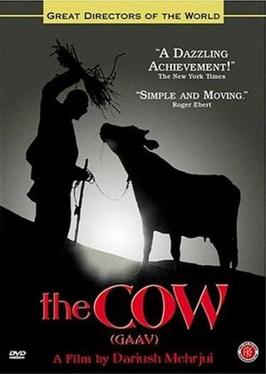Introduction:
“The Cow,” a 1969 Iranian film directed by Dariush Mehrjui, stands as an enduring masterpiece in the world of cinema. Renowned for its powerful storytelling, poetic cinematography, and profound exploration of the human condition, the film remains a pivotal work in Iranian cinema. This extensive review delves into the thematic richness, cultural significance, and the lasting impact of “The Cow,” showcasing its timeless portrayal of loss, desolation, and the indomitable spirit of humanity.
Section 1: Contextualizing “The Cow” in Iranian Cinema
1.1 Post-Revolutionary Iranian Cinema
“The Cow” emerges from the context of post-revolutionary Iranian cinema, a period characterized by a renaissance in storytelling and artistic expression. Directed by Dariush Mehrjui, the film is often hailed as a pioneer in the Iranian New Wave, reflecting a departure from traditional narrative structures and introducing a more introspective approach to filmmaking.
1.2 Mehrjui’s Artistic Contribution
Dariush Mehrjui, a prominent figure in Iranian cinema, played a pivotal role in shaping the trajectory of the country’s filmmaking. “The Cow” is a testament to Mehrjui’s artistic vision, exploring themes that resonate universally while capturing the nuances of Iranian culture and society. The film’s narrative innovation and visual poetry set the stage for a new wave of Iranian filmmakers.
Section 2: A Cinematic Elegy for Desolation
2.1 The Tragic Tale of Hassan
At the heart of “The Cow” is the tragic tale of Hassan, a poor villager in a rural Iranian community who loses his beloved cow. The film weaves a poignant narrative around Hassan’s emotional attachment to the cow and the profound impact of its loss on both his psyche and the close-knit community. The story unfolds as a reflection on grief, resilience, and the interconnectedness of life.
2.2 Metaphor and Symbolism
Mehrjui employs metaphor and symbolism to elevate the narrative beyond a simple tale of loss. The cow becomes a symbolic vessel, embodying not just a source of sustenance but also a metaphor for the fragility of life and the precarious balance between nature and humanity. The film’s depth lies in its ability to transcend the specific circumstances of Hassan’s loss and resonate with audiences on a universal level.
Section 3: Visual Poetry and Cinematographic Brilliance
3.1 Aesthetic Mastery
“The Cow” is celebrated for its aesthetic mastery, exemplified by the breathtaking cinematography of Mehrjui and his collaboration with cinematographer Fereydoun Ghovanlou. The film captures the rural landscapes with a painterly eye, immersing viewers in the stark beauty of the Iranian countryside. Each frame is a visual poem that enhances the emotional resonance of the narrative.
3.2 Naturalism and Atmosphere
Mehrjui’s commitment to naturalism contributes to the film’s authenticity. The use of natural light, unembellished sets, and a deliberate avoidance of artifice create an atmosphere that is both raw and immersive. This commitment to realism allows the audience to be fully immersed in the world of the characters, amplifying the emotional impact of Hassan’s journey.
Section 4: Human Resilience Amidst Desolation
4.1 Character Exploration: Hassan’s Journey
The character of Hassan serves as the emotional anchor of “The Cow.” As he grapples with the loss of his cow, the film explores the depths of human resilience. Hassan’s journey becomes a universal narrative of coping with adversity, grief, and the relentless passage of time. Mehrjui’s portrayal of Hassan transcends cultural boundaries, offering a window into the human soul.
4.2 Community Dynamics and Empathy
“The Cow” is not just a solitary exploration of one man’s grief but a reflection on the dynamics of a close-knit rural community. The villagers, connected by shared struggles and communal bonds, collectively shoulder the weight of Hassan’s tragedy. The film becomes a meditation on empathy, illustrating how a community’s resilience is tested and strengthened in the face of shared sorrow.
Section 5: Social Commentary and Cultural Nuances
5.1 The Socioeconomic Landscape
Mehrjui’s film is deeply rooted in the socioeconomic realities of rural Iran. The scarcity of resources, the cyclical nature of poverty, and the struggles of subsistence farming become essential elements of the narrative. “The Cow” serves as a commentary on the challenges faced by marginalized communities, shedding light on the broader socioeconomic context of Iranian society.
5.2 Cultural Nuances and Traditions
Embedded within the film are cultural nuances and traditions that add layers of authenticity. The rituals surrounding death, the communal mourning practices, and the interconnectedness of daily life with agricultural rhythms offer glimpses into the rich tapestry of Iranian rural culture. Mehrjui’s attention to these details enriches the narrative with cultural specificity.
Section 6: Critical Reception and International Impact
6.1 Locally Revered, Globally Acclaimed
“The Cow” received critical acclaim both locally and internationally. Within Iran, the film is celebrated for its portrayal of rural life and its poetic exploration of human emotions. Internationally, it garnered attention at film festivals and solidified Dariush Mehrjui’s reputation as a master storyteller. The film’s resonance across cultures highlighted the universal themes that transcended geographical boundaries.
6.2 Legacy and Influence on World Cinema
“The Cow” left an indelible mark on world cinema, influencing filmmakers and audiences alike. Its impact resonates in the works of subsequent Iranian directors and contributes to the global appreciation of Iranian cinema. The film’s legacy endures as a testament to the power of storytelling that transcends cultural contexts.
Section 7: Conclusion
In conclusion, “The Cow” stands as a cinematic triumph that transcends the confines of time and culture. Dariush Mehrjui’s masterpiece is a poetic meditation on loss, resilience, and the interconnectedness of humanity. The film’s visual brilliance, cultural authenticity, and thematic depth elevate it to a realm of cinematic artistry that continues to captivate audiences worldwide. “The Cow” is not just a film; it is a testament to the enduring power of storytelling to evoke empathy, provoke reflection, and remind us of the profound beauty that emerges from the human spirit’s capacity to endure, even in the face of desolation.
